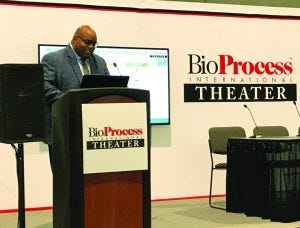- Sponsored Content
The Perks and Pitfalls of a Single-Use Biopharmaceutical Facility
August 21, 2018
Sponsored by Avid Bioservices
 Sun Ra Bullins, director of manufacturing, Avid Bioservices
Sun Ra Bullins, director of manufacturing, Avid Bioservices
Avid Bioservices is a dedicated commercial contract development and manufacturing organization (CDMO) with over 13 years of commercial manufacturing experience. It received six CMO leadership awards in 2018. Avid has a new state-of-the-art facility (2016) in Myford, CA, which has been designed for fully disposable manufacturing with up to 2,000-L capacity; and a legacy commercial facility with stainless steel bioreactors up to 1,000 L in Franklin, CA.
In designing the Myford facility, Avid specified that it meet strict commercial compliance standards, use technologies that meet the needs of a variable client base, and be a flexible facility that could make changes based on different process and product needs. The design focused on personnel and process flows, with the plant up and running in 13 months.
The perks of implementing single-use technologies (SUT) include their inherent flexibility and an ability to work on varied processes and products. Other benefits are real cost and time savings because you can balance demand and build time more easily, along with achieving significant operational benefits. SUT can be used in expansion, production, and purification.
A case study illustrating SUT flexibility involved technology transfer of a customer-designed process with that customer’s own SUTs, in which Avid was able to initiate the first CGMP production run in under four months. In a second case, a client operated at 300-L stainless steel scale. Avid moved the work successfully into a 1,000-L SU bioreactor and performed validation runs. In a third case, it rapidly scaled up from a 1,000-L stainless steel bioreactor to a 2,000-L SU bioreactor and demonstrated product comparability.
The cost and time benefits of using SUT are lowered capital outlay, shortened times from concept to completion, reduced infrastructure, lessened validation, and efficient use of existing shell space. In the classic model, a facility is built based on current available information on maximum product demand. If demand diminishes, possibly because of a patent expiring, you end up with unused space. In a flexible model using SUT, you can build based on available information for the minimum demand but then build or use another facility to meet increasing demand. When demand drops, you can rededicate the second facility to something else.
Avid already has a design for increasing capacity. Flexible facilities can go online rapidly, enabling early revenue generation. Operational benefits with a flexible facility are reduced changeover time so that a company can perform more runs per year, reduced validation requirements, reduced use of utilities, and reduced risk of contamination.
SUT pitfalls include fluid management, material control, and downstream limitations. Fluid management can be a problem if you need to mix and store large-volume solutions. Also, downstream fluid requirements can be five times the bioreactor volume for each process step. These problems are compounded in purification of high-titer products. Current solutions are to perform multiple cycles downstream to lessen fluid requirements or to daisy-chain multiple small-volume tanks. A new idea that is used in the biomanufacturing industry is to use buffer concentrates with in-line dilution. With more study, that might be implemented more often in the future.
The problem with material control is increased pressure on the supply chain because you are using consumable products. You must have warehouse space, and long lead times (over 20 weeks) are at odds with customization, rapid execution, and operational flexibility. Also, sourcing concerns arise particularly when transporting around the world, both moving materials without interruption and knowing how SU materials were made. Solutions are to plan for growth and storage needs, develop strong vendor relationships, purchase items that can be used across processes, and use risk-based approaches when sourcing and determining impact to patient safety.
The downstream disparity comes because downstream throughput is limited by equipment capability, so separation and purification operations cannot move as quickly as upstream processes do. Disposable chromatography skids have maximum volumetric flow limitations at 60-cm diameters and 20-cm BH. We should encourage chromatography-column manufacturers to develop systems that would work in larger column sizes.
You May Also Like





